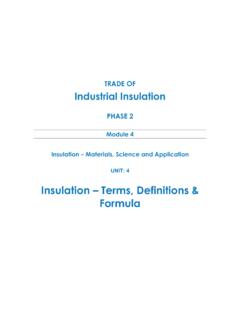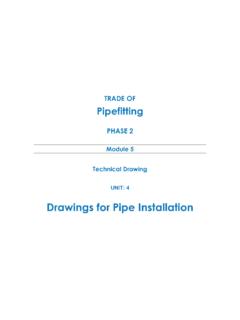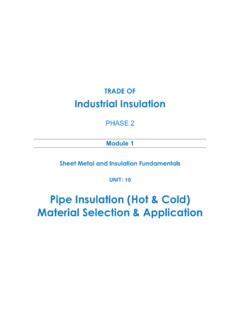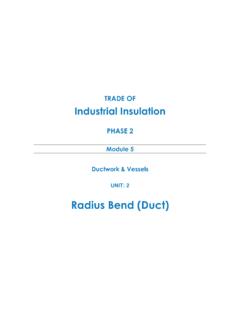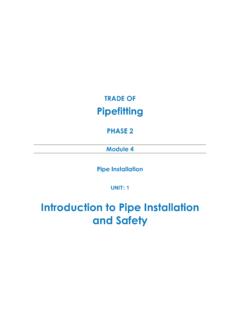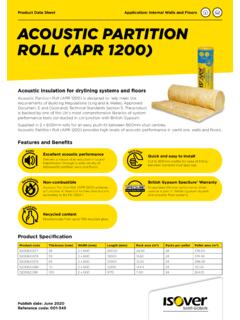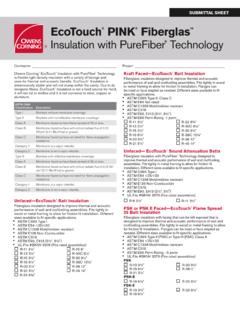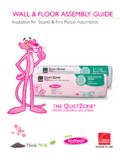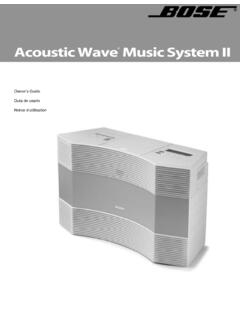Transcription of Insulation Thickness, Thermal Conductivity & Performance ...
1 TRADE OF Industrial Insulation PHASE 2 Module 4 Insulation Materials, Science and Application UNIT: 3 Insulation thickness , Thermal Conductivity & Performance Criteria Produced by In cooperation with subject matter expert: Michael Kelly SOLAS 2014 Module 4 Unit 3 Industrial Insulation Phase 2 Insulation thickness , Thermal Conductivity & Performance Criteria Revision , August 2014 Table of Contents Introduction .. 1 Unit Objective.. 2 Selection of Correct Insulation Material thickness for a Specified Application .. 3 Range of Insulation Materials Indoor/Outdoor Applications .. 3 Use of Data Sheets for Material Selection, Thermal Conductivity and Performance Criteria.
2 5 Effects of Environmental Conditions .. 5 Integration of New Technologies and Materials .. 5 Selection of Appropriate Material thickness and Performance Criteria 6 thickness Selection and Performance Requirements for Insulating Materials .. 6 Thermal Conductivity .. 6 Multiple Layering of Insulation Staggering of Joints.. 7 Calculation of Material thickness to Achieve Heat Loss Values .. 8 Heat Loss Calculations .. 8 Area, Volume and Density .. 8 Heat Loss and Insulation thickness .. 9 Summary .. 10 Module 4 Unit 3 Industrial Insulation Phase 2 1 Insulation thickness , Thermal Conductivity & Performance Criteria Revision , August 2014 Introduction Selecting the correct insulating material for a specified application is of the utmost importance.
3 There are a number of factors to be taken into account when designing an insulating system, including temperature, location, safety, corrosion and cost of materials and installation. Designing a system which includes all of the above requires the designer to have an in depth knowledge of different insulating materials. We can make this job a little easier by consulting with Insulation manufacturers . They will provide you with the necessary details including material data sheets, forms of supply and costs. Module 4 Insulation Materials, Science & Application Unit 1 Basic Insulation Science & Principles Unit 2 Insulation Materials & System Design Unit 3 Insulation thickness , Thermal Conductivity & Performance Criteria Unit 8 Sprayed or Blown Fibre & Ceramic Fibre (Blanket)
4 Unit 7 Calcium Silicate & Magnesia Unit 6 Cellular Glass or Foamed Glass Unit 5 Glass Mineral Fibre & Rockwool Unit 4 Insulation Terms, Definitions & Formula Unit 15 Finishing Materials & Cladding Unit 14 Acoustics/ Noise Abatement Unit 13 Fire Protection Unit 12 Asbestos Unit 11 Polystyrene, Phenolic Foam & Polyisocyanurate Foam Unit 10 Nitrile Rubber Unit 9 Vermiculite Module 4 Unit 3 Industrial Insulation Phase 2 2 Insulation thickness , Thermal Conductivity & Performance Criteria Revision , August 2014 Unit Objective. By the end of this unit each apprentice will be able to: Select correct Insulation material thickness for a specified application from product data sheets.
5 State the criteria for selection of appropriate material thickness for specific purposes. Calculate the material thickness to achieve the required heat loss values. Module 4 Unit 3 Industrial Insulation Phase 2 3 Insulation thickness , Thermal Conductivity & Performance Criteria Revision , August 2014 Selection of Correct Insulation Material thickness for a Specified Application Range of Insulation Materials Indoor/Outdoor Applications The following table illustrate the name of the Insulation material and its temperature application. Name of Insulation Material Temperature Areas of Application Remarks Glass Mineral Wool Up to 230 C Attic Insulation Made from Sand and recycled glass Cavity Wall Insulation Limestone and Soda Ash Sound Insulation Non-Combustible Industrial Plant/Pipe work Lightweight Ventilation Ductwork Cost Effective Rock Mineral Wool Up to 850 C Floor, Wall.
6 Roofs and Made mainly from volcanic rock Boiler room Insulation Typically basalt and/or docomite Ventilation Plant Resists high temperatures acoustic Ceilings Water repellent Partition Panels Cost effective Industrial Plant/Pipe work Polystyrene Foam Up to and not more than +75 C Roofing, cold storage refrigerated transport. Non toxic and non irritant. Resistant to water penetration, low cost ( lower than mineral wools).Key Learning Points Range of Insulation materials Indoor/Outdoor applications Use of data sheets for material selection, Thermal Conductivity and Performance criteria. Effects of Environmental Conditions Integration of new technologies and materials Module 4 Unit 3 Industrial Insulation Phase 2 4 Insulation thickness , Thermal Conductivity & Performance Criteria Revision , August 2014 (PUR) Mixture of agents and additives -185 C to +110 C Very low Thermal Conductivity .
7 Slightly more expensive but installation costs are lower. (PIR) Polyisocyanurate -185 C to +140 C Petrochemical equipment, buildings, refrigerated vehicles, tankers and ducting. More expensive better fire Performance . Phenolic Foam -185 C to +120 C Air conditioning ducting, dry lining, sandwich panels Insulation . Very low Thermal Conductivity . Does not melt when exposed to flame. Nitrile Rubber -40 C to +105 C Heating water, steam and condensate. Chilled water and refrigeration ductwork. Resistant to oil chemical and ozone lightweight and flexible. Calcium Silicate C to + C Back up Insulation in the refractory industry, boilers ducting and process pipe work.
8 More expensive than mineral wool. Cellular Glass C to C Process plant application and wide range of building application. Resistant to water vapour, high compressive strength and good chemical resistance. Non- combustible. High production cost. Expanded Vermiculate Up to 1000 C Cementitious binders to produce sprays or boards as a fire protection product. Naturally occurring material, light weight, granular material, insert and high melting point. Perlite Up to 650 C It is often used as a form of loose fill Insulation . Naturally occurring material. Cheaper than mineral wool. Module 4 Unit 3 Industrial Insulation Phase 2 5 Insulation thickness , Thermal Conductivity & Performance Criteria Revision , August 2014 Use of Data Sheets for Material Selection, Thermal Conductivity and Performance Criteria The use of manufacturer s data sheets in selecting the correct material is a vital part of the system design and installation procedures.
9 The manufacturer s data sheets generally contain information on the following: 1. Conformity to standards. 2. Description of the product. 3. Environmental impact of the product. 4. Performance and properties. 5. Hazards associated with the product. 6. Safety precautions. 7. What to do in case of an emergency. Effects of Environmental Conditions To offset the effects of installing Thermal Insulation in various types of adverse environmental conditions, Insulation materials should have: Resistant to attack by chemicals with which they may have come into contact with. If this is not practical, then the Insulation should be provided with a resistant coating or jacket.
10 Resistance to moisture sufficient that they do not deteriorate under wet conditions. This is particularly important when operating in the open. Resistance to vibration, mechanical shock, and abrasion or, as most insulants by their nature are mechanically weak, at least protection against damage by same. Weathering and protection for the purpose of elimination of ingress of moisture, protection against fire and mechanical damage and against corrosion. Integration of New Technologies and Materials New materials are being developed on a constant basis, which are more energy efficient and cost effective. Architects and engineers are using processes that are environmentally responsible and resource-efficient throughout a building's life-cycle: from design, construction, operation, maintenance and renovation.
